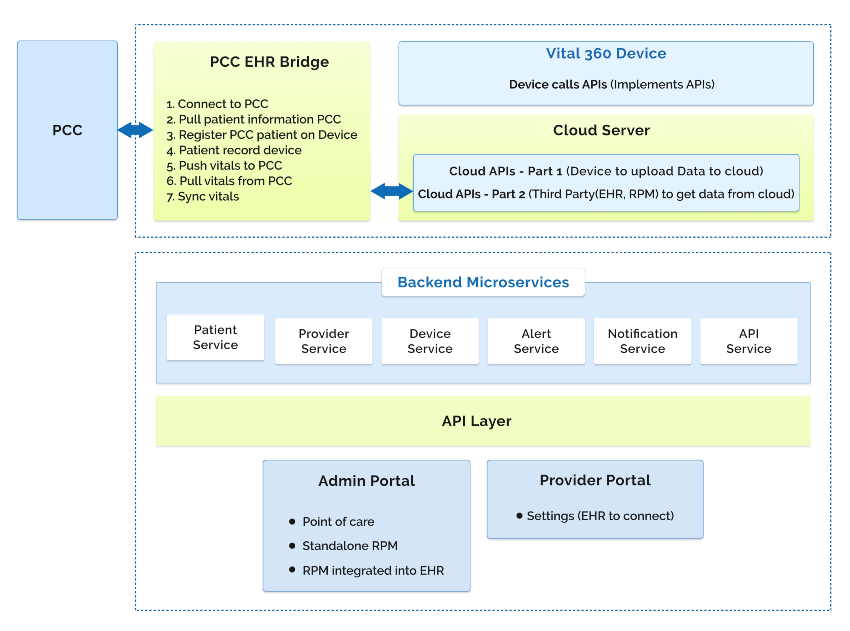Client Requirements
A client from the United States wanted to solve the problem of manual entry of vitals into the EHR system. Clients wanted to make a system that would automatically fetch the vital details from the system to the EHR. The client wanted to develop a tool that captures pulse, blood oxygen, EKG, respiratory rate, temperature, weight, glucose, etc. They need assistance developing software to bridge the gap between the device and the EHR system.
The client's goal was to allow patients to collect and send health vitals from anywhere in the world. The tool aids in providing Remote Patient Monitoring (RPM) and Telehealth solutions. Healthcare providers with cellular, Wi-Fi, and Bluetooth capability can remotely capture key clinical vital sign measurements from a single self-contained device and securely upload the data via the cloud into the provider's clinical information system. The client is looking for a solution that will automatically retrieve data from the device and push it into the system.
The client wanted to create a HIPAA-compliant Remote Patient Monitoring application to help them grow their business by offering patients value-added services.
The specialist hopes to increase revenue through EHR application by providing additional services, reducing the patient's inconvenience, and improving the service quality. The billing cycle solution was one of the key and exciting requirements of the client.
Thinkitive Solution
The requirement analysis (Discovery) phase was initiated by Thinkitive's business analysts and subject matter experts. The team worked on the requirement gathering and research and suggested a solution best suited to the client's business. The creative team took calls with clients on multiple occasions, creating detailed Functional requirement documents, designing low-fidelity prototypes, and taking timely approvals from the client. Thinkitive assembled a team of experts in both frontend and backend development.
The innovative team employs microservice-based architecture and creates separate microservices for each module. The patient, provider, and admin will have their separate login, and the patient will take the vitals via the device. The team developed a backend application in Spring boot to automate the process. For more information, please see the diagram below.

Solution Highlights
-
Onboard Patients:
Providers can easily add new patients by entering their demographics, insurance, contact information, family information, and medical history. Depending on the patient's health, the providers establish a monitoring team to track their progress.
-
Point of Care Mode with Single Multipurpose Device:
Clinicians can care for multiple patients in point-of-care mode. POC stores all demographics and vital signs information in a cloud database which is captured using a multipurpose IoMT device assigned to a patient. The system records all of the information and displays the patient demographics. Patients can confirm their information and upload their vitals if the system is connected.
-
Stand-alone Mode:
The stand-alone mode would allow providers or patients to take vitals offline. The Stand Alone mode will allow providers to check the patient's condition without storing or uploading any data.
-
The Remote Patient Monitoring Platform:
The EHR software development system retrieves data automatically, eliminating the need for additional time spent on attempting to capture readings and manually transcribe or upload them. The system is easy-to-use and provides a comprehensive view of the patient's health from the comfort of their home.
-
Monitor Vitals:
Track a wide range of clinical data, including vital signs, blood glucose levels, heart rate, sleep data, and more.
-
Easy Device Integration:
The system integrates with health devices and the Care Program to track patients' vitals anywhere and at any time. The system enables providers to assign devices based on the program and the patient's needs. The assigned devices are integrated with the EHR, allowing them to pull or push data directly to the EHR. Integrating patient vitals tracking into provider systems makes tracking and reviewing past vitals history easier.
-
HIPAA- Compliant Chat, Phone, and Video Consultation :
In an emergency, the patient can contact a provider anytime, day or night. Chat with providers and share medical records using HIPAA-compliant messaging.
-
Automatic Alerts :
Alerts will be sent to providers and other users if the system detects vitals outside the normal range.
-
Care Team and Nurses :
Providers can assign care team members to patients and nurses using the system. If a patient's condition worsens, all care team members are notified. Chat allows patients and providers to communicate with one another and the care team in real-time. This enables more precise tracking of chronic care plans, symptoms, and health status updates.
-
Create Patient-centered Care Plans that are Adaptable :
The system employs analytics to display real-time health trends for patients. Providers use RPM daily care plans to help patients stay on track every day and align daily outcomes to meet goals. The system allows providers to create customizable Care Plan templates that can be altered and used to assign patients as needed.
1. Create a customizable RPM Care Plan.
2. Assigning a care plan to the patient.
3. Add vitals to the tracking list of the device.
4. Add devices to collect vital signs and monitor patient health.
5. Create alerts based on the patient's current health status.
6. In the event of an emergency, add a member to be notified.
Value Delivered
-
Reduce total monitoring costs by simplifying deployments and device management.
-
Provides real-time vitals into the provider's telehealth system or EMR.
-
Allows telehealth companies to communicate with patients via two-way video.
-
Telehealth significantly expands the number of services available.
-
RPM services are available for both acute and chronic illnesses.
-
Allows the provider to communicate with patients anytime and from any location.
